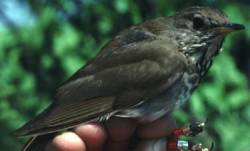- Bicknell's Thrush
Taxobox
name = Bicknell's Thrush
status = VU | status_system = IUCN3.1
trend = down

regnum =Animal ia
phylum = Chordata
classis = Aves
ordo =Passeriformes
familia =Turdidae
genus =Catharus
species = "C. bicknelli"
binomial = "Catharus bicknelli"
binomial_authority = (Ridgway, 1882)
synonyms ="Catharus minimus bicknelli"The Bicknell's Thrush, "Catharus bicknelli", is a medium-sized thrush.
Adults are olive-brown on the upperparts, slightly redder on the tail. The underparts are white with gray on the flanks; the breast is greyish brown with darker spots. They have pink legs, a faint grey eye ring, and gray cheeks. They are slightly smaller than the very similar
Gray-cheeked Thrush but apart from that all but indistinguishable in outward appearance. Together with this, it forms acryptic species pair and was indeed formerly consideredconspecific [http://elibrary.unm.edu/sora/Wilson/v105n04/p0545-p0572.pdf] .Bicknell's and the Gray-cheeked Thrush make up a close-knit group of migrant species together with theVeery (Winker & Pruett, 2006).Their breeding habitat is the
conifer ous forests in southeasternQuebec toNova Scotia and northernNew England andNew York state. These birds are usually found at higher elevations. They make a bulky cup nest close to the trunk of aconifer .These birds migrate to the
West Indies , (theGreater Antilles ), with an estimated 90% of the individuals wintering onHispaniola [http://www.soh.org.do/Palmchatter1_2%20English.pdf] .They forage on the forest floor, mainly eating insects, wild fruits and berries.
This bird's song is a jumbled series of flute-like tones ending on a higher note. They are very secretive during the nesting season.
This bird's numbers are declining in some parts of its already limited range as a result of
habitat destruction .This bird was named after Eugene Bicknell, an American amateur
ornithologist , who discovered the species on Slide Mountain in the Catskills in the late 19th century.References
* [http://www.iucnredlist.org/search/rangemap.php?species=40470 RangeMap] Database entry includes a range map and justification for why this species is vulnerable.
* Winker, Kevin & Pruett, Christin L. (2006): Seasonal migration, speciation, and morphological convergence in the avian genus "Catharus" (Turdidae). "Auk" 123(4): 1052-1068. [Article in English with Spanish abstract] DOI: 10.1642/0004-8038(2006)123 [1052:SMSAMC] 2.0.CO;2 [http://www.uaf.edu/museum/bird/personnel/KWinker/Catharus%20Auk%202006.pdf PDF fulltext]
External links
*
Environment Canada : [http://www.ns.ec.gc.ca/wildlife/bicknells_thrush/e/ Bicknell's Thrush]
* [http://www.ffdp.ca/index_e.asp Hinterland Who's Who] : [http://www.ffdp.ca/hww2.asp?id=28 Bicknell's Thrush]
* [http://www.birds.cornell.edu/AllAboutBirds/BirdGuide/ Cornell Lab of Ornithology All About Birds Bird Guide] : [http://www.birds.cornell.edu/AllAboutBirds/BirdGuide/Bicknells_Thrush_dtl.html Bicknell's Thrush]
* [http://vireo.acnatsci.org/search.html?Form=Search&SEARCHBY=Common&KEYWORDS=bicknell%27s+thrush&showwhat=images&AGE=All&SEX=All&ACT=All&Search=Search&VIEW=All&ORIENTATION=All&RESULTS=24 Bicknell's Thrush photo gallery] VIREO
* [http://www.iucnredlist.org/search/rangemap.php?species=40470 IUCN Bicknell's Thrush rangemap]Bibliography
* Environmnent Canada: Bicknell's Thrush: [http://www.ns.ec.gc.ca/wildlife/bicknells_thrush/e/bibliography.html Bibliography]
Wikimedia Foundation. 2010.
